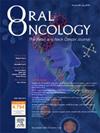Are we ready to use ultrasounds in the clinical assessment of depth of invasion and tumor thickness in oral squamous cell carcinoma? Results from a systematic review, meta-analysis and trial sequential analysis
IF 4
2区 医学
Q1 DENTISTRY, ORAL SURGERY & MEDICINE
引用次数: 0
Abstract
Objectives
To investigate the accuracy of ultrasound in the quantification of tumor thickness (TT) and depth of invasion (DOI) of oral potentially malignant disorders and oral squamous cell carcinoma.
Materials and methods
A systematic review search was conducted in PubMed, Scopus, and Web of Science to answer the PICO question: “What is the correlation and the mean difference between ultrasound and histopathological assessment of tumor thickness and depth of invasion in patients with oral squamous cell carcinoma and oral potentially malignant disorders? The risk of bias was assessed, meta-analysis and trial sequential analysis was conducted on the available quantitative data, followed by trial sequential analysis.
Results
Of 2089 results, 48 studies were considered suitable for inclusion.
Meta-analysis showed a low heterogeneity for tumor thickness mean difference (I2 = 0.00 %) with an overall standardized mean difference (SMD) of 0.13 (95 % CI: −0.07 to 0.33, p = 0.214). Tumor thickness correlation showed high heterogeneity (I2 = 93.41 %). For depth of invasion, the mean difference had moderate heterogeneity (I2 = 8.98 %) with an overall SMD of 0.27 (95 % CI: 0.06 to 0.48, p = 0.013). However, correlation analysis showed moderate heterogeneity (I2 = 56.22 %). Trial sequential analysis confirmed the tumor thickness results but indicated more studies are required for depth of invasion to meet the required information size.
Conclusion
There were no statistically significant differences between the results of ultrasound and histological examination, the clinical use of this device cannot yet be confirmed.
在临床评估口腔鳞状细胞癌的浸润深度和肿瘤厚度时,我们准备好使用超声波了吗?系统综述、荟萃分析和试验序列分析的结果。
目的研究超声在量化口腔潜在恶性疾病和口腔鳞状细胞癌的肿瘤厚度(TT)和浸润深度(DOI)方面的准确性:在 PubMed、Scopus 和 Web of Science 中进行了系统综述搜索,以回答 PICO 问题:"口腔鳞状细胞癌和口腔潜在恶性疾病患者的肿瘤厚度和浸润深度的超声评估与组织病理学评估之间的相关性和平均差异是多少?对偏倚风险进行评估,对现有定量数据进行荟萃分析和试验序列分析,然后进行试验序列分析:在 2089 项结果中,有 48 项研究被认为适合纳入。荟萃分析表明,肿瘤厚度平均差异的异质性较低(I2 = 0.00 %),总体标准化平均差异(SMD)为 0.13(95 % CI:-0.07 至 0.33,P = 0.214)。肿瘤厚度相关性显示出高度异质性(I2 = 93.41 %)。就侵袭深度而言,平均差异具有中度异质性(I2 = 8.98 %),总体 SMD 为 0.27(95 % CI:0.06 至 0.48,p = 0.013)。然而,相关性分析显示存在中度异质性(I2 = 56.22 %)。试验序列分析证实了肿瘤厚度的结果,但表明还需要更多关于浸润深度的研究才能达到所需的信息量:结论:超声检查结果与组织学检查结果之间没有统计学意义上的显著差异,该设备的临床应用尚未得到证实。
本文章由计算机程序翻译,如有差异,请以英文原文为准。
求助全文
约1分钟内获得全文
求助全文
来源期刊

Oral oncology
医学-牙科与口腔外科
CiteScore
8.70
自引率
10.40%
发文量
505
审稿时长
20 days
期刊介绍:
Oral Oncology is an international interdisciplinary journal which publishes high quality original research, clinical trials and review articles, editorials, and commentaries relating to the etiopathogenesis, epidemiology, prevention, clinical features, diagnosis, treatment and management of patients with neoplasms in the head and neck.
Oral Oncology is of interest to head and neck surgeons, radiation and medical oncologists, maxillo-facial surgeons, oto-rhino-laryngologists, plastic surgeons, pathologists, scientists, oral medical specialists, special care dentists, dental care professionals, general dental practitioners, public health physicians, palliative care physicians, nurses, radiologists, radiographers, dieticians, occupational therapists, speech and language therapists, nutritionists, clinical and health psychologists and counselors, professionals in end of life care, as well as others interested in these fields.
 求助内容:
求助内容: 应助结果提醒方式:
应助结果提醒方式:


